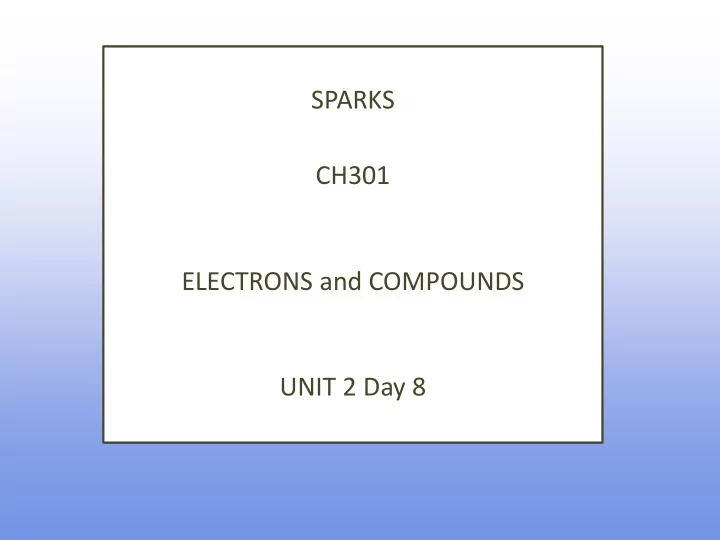

SPARKS CH301 ELECTRONS and COMPOUNDS UNIT 2 Day 8
What are we going to learn today? −Electron Configuration and Bonding • Employ the concept of resonance • Use formal charge to help predict best possible Lewis structure
INDIVIDUAL QUIZ: NO TALKING! Naming Compounds Choose the formula that corresponds to: strontium and phosphorus. a) SrP b) SrP 2 c) Sr 2 P d) Sr 3 P 2 e) Sr 2 P 3
INDIVIDUAL QUIZ: NO TALKING! Naming Compounds Choose the formula that corresponds to: potassium dichromate. a) KCrO 4 b) KCr 2 O 7 c) K 2 CrO 4 d) K 2 Cr 2 O 7 e) K 3 Cr 2 O
INDIVIDUAL QUIZ: NO TALKING! Naming Compounds Choose the formula that corresponds to: sulfur trioxide. a) SO 2- b) SO 3 c) SO 3 d) S 2 O 3 2- e) SO 4
INDIVIDUAL QUIZ: NO TALKING! Naming Compounds Choose the formula that corresponds to: sulfite. a) SO 2- b) SO 3 c) SO 3 d) S 2 O 3 2- e) SO 4
INDIVIDUAL QUIZ: NO TALKING! Naming Compounds Choose the name that corresponds to: NH 4 OH. a) nitrogen tetrahydrogen oxygen hyrdride b) nitrogen pentahydrogen oxide c) ammonium hydroxide d) ammonia oxyhydrogen e) hydronitrideoxide
Course packet p. 44 Finish that? Here are some more structures to try: PCl 3 CH 3 CH 2 OCHCH 2 NH 2 CH 2 CHCH 2 XeF 4
COCl 2 : Which Structure is Best? Formal Charge check Used when more than one Lewis structure can be drawn. Determines which is most plausible . # valence + # shared electrons - # nonbonding F.C. = electrons 2 electrons Sum of the FC’s for all atoms = overall charge (zero for neutral molecule)
• Essentially, we are comparing – the number of valence electrons in the neutral, free atom WITH – The number of valence electrons “belonging” to the atom in a molecule. • Assumptions: – Lone pairs belong entirely to the atom. – Bonding pairs are divided equally
Put these on the board...Working for candy and fame - NO 3
Resonance structures for the formate ion are shown below. POLL: CLICKER QUESTION An average C-O single bond is 0.143 nm in length An average C=O double bond is 0.123 nm in length. Which choice describes the actual bond lengths for the carbon-oxygen bonds in a formate ion? A. Both carbon-oxygen bonds are 0.133 nm. B. Both carbon-oxygen bonds are 0.143 nm. C. One carbon-oxygen bond is 0.143 nm and the other is 0.123 nm. D. Both carbon-oxygen bonds switch between 0.123 nm and 0.143 nm.
Think about it …. Ionic or covalent? NaOH
Compounds of Polyatomic Ions: Within the ions : bonding between atoms is covalent but overall bonding between ions in the crystal is ionic.
Just when you were sure you had it nailed… RnCl 2 BeCl 2
Exceptions to Octet Rule • Be: 4 e- needed, BeCl 2 • B: 6 e- needed • Odd number of electrons in molecule
POLL: CLICKER QUESTION 1. How many resonance structures are there for ozone, O 3 ? (Note, this is not a cyclic molecule, which will be discussed later.) A. 0 B. 4 C. 2 D. 3 2. Which bonds would be stronger: those in ozone or those in oxygen (O 2 )? A. the bonds in ozone B. the bonds in oxygen C. one bond in ozone will be equal in strength to the oxygen bond; the other ozone bond will be weaker than the oxygen bond.
Consider NOC l , in which the least electronegative element is the central atom. The dot structure has a A. N-C l single bond B. N-C l double bond C. N-C l triple bond
What have we learned? ATOMS BEHAVE IN CERTAIN PREDICTABLE WAYS WHICH CAN BE CORRELATED TO THE ELECTRON CONFIGURATIONS SATISFYING THE OCTET RULE IS A SOLID PREDICTOR OF BONDING IN IONIC AND COVALENT COMPOUNDS RESONANCE IS THE AVERAGE OF THE EXTREMES – ELECTRONS ARE NOT TRAPPED IN THE LITTLE DASHES FORMAL CHARGE HELPS PREDICT BEST LEWIS STRUCTURE FOR A GIVEN MOLECULAR FORMULA
Learning Outcomes Draw the Lewis structures for molecular compounds and ions. Use Lewis structures to predict and explain the relative bond Strength and lengths in compounds. Recognize and apply exceptions to the octet rules. Draw resonance structures for a molecule or polyatomic ion. Apply formal charges to structures and use them to predict the most likely structure.
Important Information LM19 and HW due Wed. Extra help: Laude LM Lecture 9
Recommend
More recommend